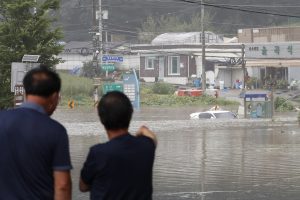At least 15 people are dead and 11 still missing as rain continues to batter the Korean Peninsula. The rain, which hammered southern parts of South Korea and the island of Jeju throughout July, is continuing in Seoul and central parts of the country. So far in the central provinces rain has fallen for 42 days straight, closing in on the record of 49 days for the longest monsoon season set back in 2013.
Heavy rains have caused severe flooding as well as deadly mudslides, leaving more than 1,000 people still without homes, and damaging thousands of hectares of farmland, roads, and bridges. The South Korean government is expected to announce soon that it is designating North and South Chungcheong and Gyeonggi provinces as special disaster zones in order to help funnel more financial and logistical assistance into the relief effort.
As rain continued to fall, water at the Soyang River dam in Gangwon province began to rise to dangerous levels, and authorities decided to open the dam to prevent potential damage to the structure. Some worried that the extra water suddenly pouring into the Han River that flows through central Seoul would cause even more flooding in the area, but officials said they did not expect any issues. In fact, they emphasized the fact that the dam has been opened 14 times in the past to relieve excess water, including in 2017.
Above the border, North Korean officials also reportedly chose to open the Hwanggang dam on the Imjin River just 26 miles north of the border to relieve rising water pressure — but failed to notify authorities in the South before doing so. Back in 2009, water gushing from that same dam killed six South Koreans after the North opened the floodgates without warning. Since then, the North Koreans had agreed to give advanced notice of any intentions to open the dam to prevent future accidents.
Critics have laid some of the blame for the destruction on the Korea Meteorological Administration (KMA) for failing to predict this extreme bout of rain to help the country prepare ahead of time. Back in May, the service announced that the summer would be exceptionally hot. But the KMA said that global warming contributed both to the extreme length and severity of the rain, as well as the unpredictability of this summer’s weather patterns.
And South Korea is not out of the woods yet. Authorities have closed potentially dangerous areas including some hiking routes and facilities near streams and rivers out of concerns for further flooding and landslides. And all of this comes as the peninsula now deals with the arrival of Typhoon Hagupit, which wreaked havoc on eastern China this week. Luckily the storm has lost some of its strength, but is bringing more heavy rain and strong winds to an already soaked Korean Peninsula.
Meanwhile, South Korea is also trying to implement relief efforts in a way that doesn’t compromise its successful containment of the COVID-19 outbreak. With so many forced to flee their homes, cities are attempting to keep displaced families apart by setting up distanced tents inside gyms and other large spaces serving as temporary shelters. Workers were also checking temperatures and encouraging mask use and regular hand-washing.

































